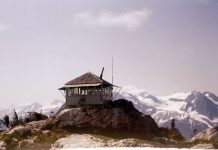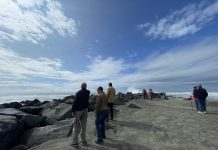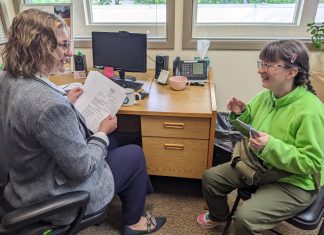From rural foothills to urban forest, countless trees shape Bellingham’s landscape. Generations have made Bellingham’s canopy their canvas, planting native and exotic trees that remain landmarks over decades.
For retired mailman and self-taught tree expert John Wesselink, cataloguing Bellingham’s trees has become a rewarding hobby. Wesselink has created seven tree maps, frequently giving tours and talks around town.
“Between 1983 and 2007, I made it my job to figure out all the trees on my mail route,” says Wesselink. “Luckily I had Elizabeth Park, which is one of the finest little tree parks between Seattle and Vancouver.”
Unable to find tree maps in Bellingham, Wesselink frequently visited Seattle Arboretum to compare specimens. “I spent many, many long weekends down there just studying and trying to figure out what made one tree different from the other,” he says.
John Wesselink’s Facebook page includes charts and maps, with more available by email request (johnswesselink@msn.com) for enthusiasts to explore.
“It just enlivens your curiosity,” says Wesselink. “I can’t walk by a tree without knowing what it is. So every walk I take is just filled with an intellectual exercise of figuring out what a new strange tree may be.”
Western Washington University
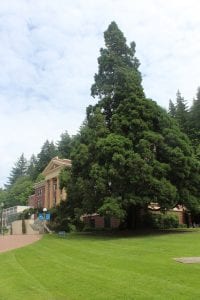
Western Washington University has “easily” the greatest tree diversity in town, according to Wesselink. The virtual WWU Campus Tree Tour highlights many trees native to Eurasia and the eastern United States.
Dr. Irving Miller planted Western’s largest tree, a giant sequoia, outside Edens Hall in 1941. Across the sidewalk is Wesselink’s favorite deciduous tree.
“It’s a lovely, gangly, gnarly old tree, certainly not the tallest of the London planes,” says Wesselink. “There’s lots of London planes on campus, but this one is the most majestic. It just twists and turns and has to be of a seriously old age.”
Western’s Chinese coffin trees, yellow buckeye, bigleaf and umbrella magnolias, and Japanese zelkovas are likely the rarest trees in Bellingham.
Columbia Neighborhood
Elizabeth Park epitomizes Columbia Neighborhood’s plethora of trees, containing over 55 species within two blocks.

“There’s a state record English oak at 106 feet at Elizabeth Park,” says Wesselink. “Four of the largest native Pacific yews in town can be found at Elizabeth Park.”
Elizabeth Park shares magnificent American elms and European copper beeches with the rest of the Columbia Neighborhood. Allegedly, the American elm between Utter Street and Eldridge Avenue came from the Cambridge, Massachusetts elm where George Washington commanded the Revolutionary Army in 1775.
“They handed out quite a few scions from this particular tree,” says Wesselink. “But it is an historically famous and historical tree.”
Landmark Urban Trees
Many trees line Bellingham’s city streets, perhaps most famously the historical dawn redwood outside the Whatcom County Courthouse.

“They actually redesigned the building to avoid having to cut that tree down,” Wesselink says. “It was a historical planting of some of the earliest Metasequoia seeds brought back from China when it was rediscovered in 1941. The seeds were collected in 1947 and planted there in 1953.”
Fairhaven’s historic trees include State Street’s Smooth Leaf elms planted on Arbor Day 1896 and one of America’s oldest Empress trees outside the Bellingham Cruise Terminal. Chinese entrepreneur Goon Dip presented the Empress to Pacific American Fisheries president E. B. Deming in 1909.
“It’s 111 years old,” Wesselink says. “They usually don’t live much past 60 or 70 years old. It’s still a lovely historical tree. A little bit the worse for wear, but it still gets those lovely purple flowers in April.”
Also in Fairhaven, 4th Street has some of Bellingham’s only Pacific crabapples outside of Whatcom Falls Park.
Wooded Parks
Common native trees tower over Bellingham’s parks, alongside rare breeds. 50 Pacific yews grow in Whatcom Falls Park, with others in Elizabeth Park, Northridge Park, and Sehome Hill Arboretum.
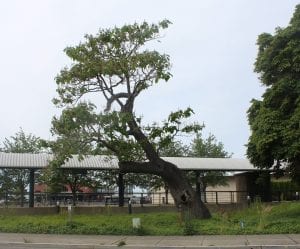
“You don’t see a lot of pacific yews in town, and you don’t see a lot of Pacific crabapples in town,” says Wesselink. “So they’re the ones I always bring attention to.”
Other rare native trees include the Pacific silver fir, chokecherry, Sitka alder, and Garry oak. Some grow in Whatcom Falls, Laurel Park, Fairhaven Lagoon, and Boulevard Trail.
Bellingham’s oldest paper birch in Bayview Cemetery, tallest Douglas fir at Arroyo Park, and tallest grand firs in Cornwall Park stand beside many other gentle giants in Bellingham’s forests.
Neighborhood Trees
Wesselink’s charts detail numerous trees on private property. Verdant neighborhoods include Edgemoor, Happy Valley, Lettered Streets, Silver Beach, and South Hill, which features a standout Atlas cedar. “Just a lovely old spreading tree,” Wesselink says. “It’s a native of Morocco and Algeria, and it’s my absolute favorite conifer in town.”

Simply by observing trees—and observing neighborhood boundaries—Bellingham locals can begin their own study.
“There’s always something new, always something interesting to find out about the historical trees we have here in Bellingham,” says Wesselink. “It’s just a wonderful thing to keep one’s walks through the woods, and even through the neighborhoods and downtown, completely fascinating.”






